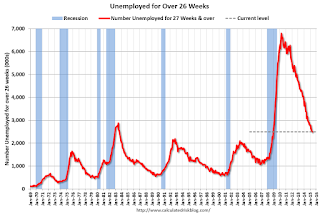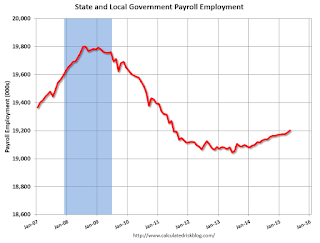by Calculated Risk on 6/05/2015 10:01:00 AM
Friday, June 05, 2015
May Employment Report Comments and Graphs
Earlier: May Employment Report: 280,000 Jobs, 5.5% Unemployment Rate
This was a solid employment report with 280,000 jobs added, and March and April were revised up by a combined 32,000 jobs.
There was even some hints of wage growth, from the BLS: "In May, average hourly earnings for all employees on private nonfarm payrolls rose by 8 cents to $24.96. Over the year, average hourly earnings have risen by 2.3 percent." Weekly hours were unchanged.
A few more numbers: Total employment increased 280,000 from April to May and is now 3.3 million above the previous peak. Total employment is up 12.0 million from the employment recession low.
Private payroll employment increased 262,000 from April to May, and private employment is now 3.8 million above the previous peak. Private employment is up 12.6 million from the recession low.
In May, the year-over-year change was just under 3.1 million jobs.
Overall this was a very positive report.
Employment-Population Ratio, 25 to 54 years old

In the earlier period the participation rate for this group was trending up as women joined the labor force. Since the early '90s, the participation rate moved more sideways, with a downward drift starting around '00 - and with ups and downs related to the business cycle.
The 25 to 54 participation rate was unchanged in May at 81.0%, and the 25 to 54 employment population ratio was unchanged at 77.2%. As the recovery continues, I expect the participation rate for this group to increase a little more (or at least stabilize for a couple of years) - although the participation rate has been trending down for this group since the late '90s.
Average Hourly Earnings

The graph shows the nominal year-over-year change in "Average Hourly Earnings" for all private employees. Nominal wage growth increased 2.3% YoY, and the pace is increasing. Wages will probably pick up a little more this year.
Note: CPI has been running under 2%, so there has been some real wage growth.
Part Time for Economic Reasons

The number of persons employed part time for economic reasons (sometimes referred to as involuntary part-time workers) was about unchanged at 6.7 million in May and has shown little movement in recent months. These individuals, who would have preferred full-time employment, were working part time because their hours had been cut back or because they were unable to find a full-time job.The number of persons working part time for economic reasons increased in May to 6.65 million from 6.58 million in April. This suggests slack still in the labor market. These workers are included in the alternate measure of labor underutilization (U-6) that was unchanged at 10.8% in May.
Unemployed over 26 Weeks
 This graph shows the number of workers unemployed for 27 weeks or more.
This graph shows the number of workers unemployed for 27 weeks or more. According to the BLS, there are 2.502 million workers who have been unemployed for more than 26 weeks and still want a job. This was down from 2.525 million in April.
This is trending down - and is at the lowest level since November 2008 - but is still very high.
State and Local Government
 This graph shows total state and government payroll employment since January 2007. State and local governments had lost jobs for four straight years. (Note: Scale doesn't start at zero to better show the change.)
This graph shows total state and government payroll employment since January 2007. State and local governments had lost jobs for four straight years. (Note: Scale doesn't start at zero to better show the change.) In May 2015, state and local governments added 15,000 jobs. State and local government employment is now up 160,000 from the bottom, but still 598,000 below the peak.
State and local employment is now generally increasing - slowly. And Federal government layoffs appear to have ended (Federal payrolls added 3,000 jobs in May, and Federal employment is up 6,000 year-to-date).
This was a solid employment report for May.


